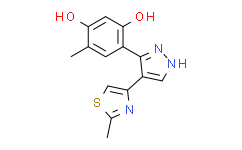Glucokinase is an enzyme that facilitates phosphorylation of glucose to glucose-6-phosphate.Humans and the majority of other vertebrates have cells in their liver, pancreas, gut, and brain that contain glucokinase. It functions as a glucose sensor in each of these organs, signaling changes in metabolism or cell function in response to rising or falling blood glucose levels, such as those that happen after meals or during fasting. Since glucosekinase has a lower affinity for glucose than the other hexokinases do and concentrates its activity in a small number of cell types, the other three hexokinases are more crucial glucose preparers for most tissues' and organs' glycolysis and glycogen synthesis.Mutations of the gene for this enzyme can cause unusual forms of diabetes or hypoglycemia.
| Structure | Cat No. | Product Name | CAS No. | Product Description |
|---|---|---|---|---|

|
V2904 | AMG-3969 | 1361224-53-4 | AMG-3969 is a potent, novelandmetabolically stabledisruptor of glucokinase-glucokinase regulatory protein interaction (GK-GKRP) with IC50of 4 nM. |

|
V20192 | Dorzagliatin | 1191995-00-2 | Dorzagliatin (RO-5305552;HMS-5552; sinogliatin)is an investigational antidiabetic agent acting as a dual-acting glucokinase activator(GKA) that is able toimproves glycaemic control and pancreatic β-cell function in type 2 diabete. |

|
V76979 | GKA50 quarterhydrate | GKA50 quarterhydrate is a potent glucokinase activator (EC50=33 nM). | |

|
V85141 | Glucocerebrosidase-IN-2 | 851185-20-1 | |

|
V25611 | MK-0941 mesylate | 1137916-97-2 | MK-0941 mesylate, the mesylate salt ofMK0941, is a novel, orally bioactive and allosteric glucokinase activator (GKA) with anti-diabetic effects. |

|
V78884 | Mortatarin F | Mortatarin F (Compound 1) is a glucosidase inhibitor (antagonist) with IC50 of 8.7 μM. | |

|
V78908 | Mortatarin G | Mortatarin G (compound 3) is a prenylated flavonoid that can be extracted from mulberry leaves. | |

|
V4556 | PF-04991532 | 1215197-37-7 | PF-04991532 is a novel, potent, hepatoselectiveglucokinaseactivator withEC50of 80 and 100 nM in human and rat, respectively. |

|
V13883 | RO 28-1675 (Ro 0281675) | 300353-13-3 | Ro 28-1675 (Ro-0281675) is a novel, potent and allosteric GK activator with a SC1.5 value of 0.24± 0.0019 uM. |

|
V79743 | Uvagrandol | Uvagrandol effectively inhibits α-glucosidase and porcine lipase (IC50= 15.2 μM and 11.2 μM, respectively). | |

|
V51000 | WAY-320081 | 66780-67-4 | glucokinase activator; HSP90 inhibitor |

|
V79295 | α-Amylase/α-Glucosidase-IN-3 | α-Amylase/α-Glucosidase-IN-3 (Compound 17) is a dual α-Amylase/α-Glucosidase inhibitor (antagonist) with IC50 s of 0.70 μM and 1.10 μM. | |

|
V81782 | α-Amylase/α-Glucosidase-IN-4 | α-Amylase/α-Glucosidase-IN-4 (compound 5) is a dual (bifunctional) inhibitor of α-glucosidase (Glucosidase) and α-amylase (Amylases), with IC50s of 0.15 μM and 1.10 μM respectively. | |

|
V81783 | α-Amylase/α-Glucosidase-IN-5 | α-Amylase/α-Glucosidase-IN-5 (compound 4l) is a dual (bifunctional) inhibitor of α-glucosidase (Glucosidase) and α-amylase (Amylases), with IC50s of 5.96 μM and 1.62 μM respectively. | |

|
V78412 | α-Glucosidase-IN-25 | α-Glucosidase-IN-25 (Compound (R)-8k) is a competitive inhibitor of α-glucosidase (glucosidase) with IC50 of 1.19 μM and may be utilized in anti-diabetic research. | |

|
V79335 | α-Glucosidase-IN-26 | α-Glucosidase-IN-26 (compound 7i) is an α-glucosidase inhibitor (IC50=4.63 µM) and may be utilized in the study of type 2 diabetes (T2DM). | |

|
V79464 | α-Glucosidase-IN-27 | α-Glucosidase-IN-27 (compound 8l) is an α-glucosidase inhibitor (IC50=25.78 μM). | |

|
V79942 | α-Glucosidase-IN-30 | α-Glucosidase-IN-30 (compound 8c) is a potent, orally bioactive, competitive α-glucosidase inhibitor (antagonist) with a Ki of 40.0 µM and IC50 of 49.0 µM . | |

|
V80138 | α-Glucosidase-IN-31 | α-Glucosidase-IN-31 (compound R1) is an orally bioavailable α-Glucosidase inhibitor (antagonist) with IC50 of 10.1 μM. | |

|
V78080 | α-Glucosidase-IN-32 | α-Glucosidase-IN-32 (compound f26) is a reversible, noncompetitive and orally bioactive α-glucosidase inhibitor (antagonist) with IC50 of 3.07 μM. |